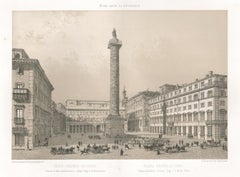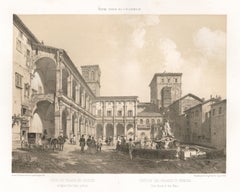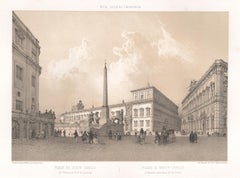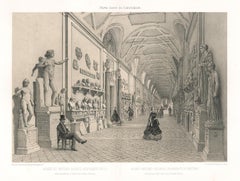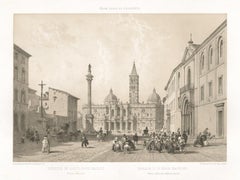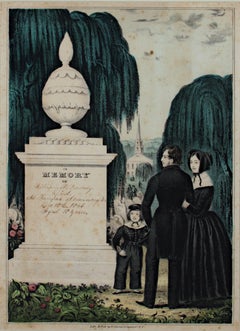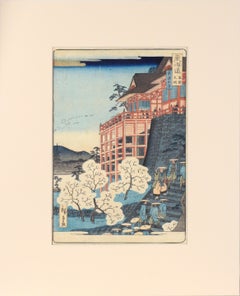Philippe Benoist Art
French, 1813-1905
Phillip Benoist was a painter, draftsman and lithographer, especially of landscapes and buildings. He was born in Geneva and worked in Paris where he was a pupil of Daguerre.
Philippe Benoist, one of the most coveted lithographers of the 19th century, specialized in topographical views. He was best known for his lithographic portfolio, including the album "Vues d'Italie et de Sicilie" with 40 lithographs, which was published by Bulla & Delarue in Paris in 1848, for which the present, delicately executed drawing served as a template. Benoist lived from 1813 to around 1880.
(Biography provided by 1515 Lincoln Gallery)
to
6
2
1
18
7
6
18
1
Overall Height
to
Overall Width
to
21
20
9
8
7
4
4
3
3
3
3
2
2
2
1
1
1
1
1
1
25
25
6,909
3,253
2,514
1,217
25
1
1
1
1
Artist: Philippe Benoist
Arc de Triomphe de L'Étoile
By Philippe Benoist
Located in Middletown, NY
from "Paris dans sa Splendeur: Monuments, Vues, Scènes Historiques, Descriptions et Histoire."
Lithograph and engraving with hand coloring in watercolor on cream wove paper, 9 3/8 x ...
Category
Mid-19th Century Barbizon School Philippe Benoist Art
Materials
Watercolor, Handmade Paper, Engraving, Lithograph
Piazza Colonna, Rome, Italy. Lithograph by Philippe Benoist
By Philippe Benoist
Located in Melbourne, Victoria
'Piazza Colonna Al Corso, Colonna Antonina - Palazzi Chigi e di Monte Citorio'
Tinted lithograph by Philippe Benoist (1813-1881). From a French series titled 'Rome dans Sa Grandeur...
Category
Late 19th Century Victorian Philippe Benoist Art
Materials
Lithograph
Cortile del Palazzo di Venezia, Rome, Italy. Lithograph
By Philippe Benoist
Located in Melbourne, Victoria
'Cortile del Palazzo di Venezia, Colla Chiesa di San Marco'
Tinted lithograph by Eugene Ciceri after Felix Benoist. Figures by Bayot. From a French series titled 'Rome dans Sa Gran...
Category
Late 19th Century Victorian Philippe Benoist Art
Materials
Lithograph
Piazza di Monte Cavallo, Rome, Italy. Tinted lithograph by Philippe Benoist
By Philippe Benoist
Located in Melbourne, Victoria
'Piazza di Monte Cavallo e Palazzo pontificio del Quirinale'
Tinted lithograph by Philippe Benoist (1813-1881). From a French series titled 'Rome dans Sa Grandeur', circa 1870.
B...
Category
Late 19th Century Victorian Philippe Benoist Art
Materials
Lithograph
Galerie Chiaramonti, Vatican, Rome, Italy. Classical sculpture. Lithograph, 1870
By Philippe Benoist
Located in Melbourne, Victoria
'Musee du Vatican - Galerie Chiaramonti (Pie VII) avec l'entree de la Salle dite le Bras Nouveau'
Tinted lithograph by Philippe Benoist (1813-1881). Titled in French and Italian.
F...
Category
Late 19th Century Victorian Philippe Benoist Art
Materials
Lithograph
Basilica di St Maria Maggiore, Rome, Italy. Tinted lithograph, Philippe Benoist
By Philippe Benoist
Located in Melbourne, Victoria
'Basilica di St Maria Maggiore. Veduta della facciata principale'
Tinted lithograph by Philippe Benoist (1813-1881). From a French series titled 'Rome dans Sa Grandeur', circa 1870...
Category
Late 19th Century Victorian Philippe Benoist Art
Materials
Lithograph
Piazza e Basilica de Santi Apostoli, Rome, Italy. Lithograph, Philippe Benoist
By Philippe Benoist
Located in Melbourne, Victoria
'Piazza e Basilica de Santi Apostoli. Palazzi Odescalchi e Colonna'
Tinted lithograph by Philippe Benoist (1813-1881). From a French series titled 'Rome dans Sa Grandeur', circa 18...
Category
Late 19th Century Victorian Philippe Benoist Art
Materials
Lithograph
'Le Louvre et La Seine, ' by Phillipe Benoist, Four-color Lithograph
By Philippe Benoist
Located in Oklahoma City, OK
This is a beautiful four-color lithograph of the Louvre by the Seine by Philippe Benoist. It is double-matted in light blue with a gold tone wooden frame.
Phillip Benoist was a p...
Category
19th Century Academic Philippe Benoist Art
Materials
Lithograph
Basilica di San Paolo, Rome, Italy. Tinted lithograph, Philippe Benoist
By Philippe Benoist
Located in Melbourne, Victoria
'Basilica di San Paolo fuori delle mura'
Tinted lithograph by Philippe Benoist (1813-1881). From a French series titled 'Rome dans Sa Grandeur', circa 1870...
Category
Late 19th Century Victorian Philippe Benoist Art
Materials
Lithograph
Cistine Chapel, Vatican, Rome, Italy. Tinted lithograph by Philippe Benoist
By Philippe Benoist
Located in Melbourne, Victoria
'Cappella Sistina in Vaticano. Un giorno di Festa'
Tinted lithograph by Philippe Benoist (1813-1881). From a French series titled 'Rome dans Sa Gr...
Category
Late 19th Century Victorian Philippe Benoist Art
Materials
Lithograph
Porto di Ripetta, Rome, Italy. Lithograph
By Philippe Benoist
Located in Melbourne, Victoria
'Porto di Ripetta. Veduta presa dalla scala della Chiesa di S. Rocco'
Tinted lithograph by Philippe Benoist (1813-1881). Figures by Bayou. From a French series titled 'Rome dans Sa...
Category
Late 19th Century Victorian Philippe Benoist Art
Materials
Lithograph
Chiesa di St Maria-Sopra-Minerva, Rome, Italy. Lithograph by Philippe Benoist
By Philippe Benoist
Located in Melbourne, Victoria
'Chiesa di St Maria-Sopra-Minerva. Veduta delle braccia di Croce'
Santa Maria sopra Minerva is one of the major churches of the Roman Catholic Order of Preachers (better known as t...
Category
Late 19th Century Victorian Philippe Benoist Art
Materials
Lithograph
Il Campidoglio (Capitoline Hill), Rome. Tinted lithograph, 1870
By Philippe Benoist
Located in Melbourne, Victoria
Tinted lithograph by Philippe Benoist (1813-1881) after Felix Benoist. Figures by Bayot.
From a French series titled 'Rome dans Sa Grandeur', circa...
Category
Late 19th Century Victorian Philippe Benoist Art
Materials
Lithograph
Loggia of Raphael, Vatican, Rome, Italy. Tinted lithograph by Philippe Benoist
By Philippe Benoist
Located in Melbourne, Victoria
'Loggia di Raffaello, in Vaticano'
Tinted lithograph by Philippe Benoist (1813-1881). From a French series titled 'Rome dans Sa Grandeur', circa 1870.
Benoist was one of France's...
Category
Late 19th Century Victorian Philippe Benoist Art
Materials
Lithograph
Paris - Eglise de L'abbaye de St Denis, French lithograph, 1861
By Philippe Benoist
Located in Melbourne, Victoria
'Eglise de L'abbaye de St Denis', tinted lithograph by Felix Benoist (1818-1896).
From a series of lithographs depicting the famous buildings of Paris - 'Paris dans sa Splendeur', p...
Category
Late 19th Century Naturalistic Philippe Benoist Art
Materials
Lithograph
Paris - Parc de Monceaux, French lithograph, 1861
By Philippe Benoist
Located in Melbourne, Victoria
'Parc de Monceaux', tinted lithograph by Felix Benoist (1818-1896).
From a series of lithographs depicting the famous buildings of Paris - 'Paris dans sa Splendeur', published in Na...
Category
Late 19th Century Naturalistic Philippe Benoist Art
Materials
Lithograph
Paris - Eglise Saint Genevieve (Ancien Pantheon), French lithograph, 1861
By Philippe Benoist
Located in Melbourne, Victoria
'Eglise St Genevieve', tinted lithograph by Felix Benoist (1818-1896).
From a series of lithographs depicting the famous buildings of Paris - 'Paris dans...
Category
Late 19th Century Naturalistic Philippe Benoist Art
Materials
Lithograph
Paris - Fontaine de la Place du Chatelet, French lithograph, 1861
By Philippe Benoist
Located in Melbourne, Victoria
'Fontaine de la Place du Chatelet', tinted lithograph by Felix Benoist (1818-1896).
From a series of lithographs depicting the famous buildings of Paris -...
Category
Late 19th Century Naturalistic Philippe Benoist Art
Materials
Lithograph
Paris - Bibliotheque du Conservatoire des Arts et Metiers, lithograph, 1861
By Philippe Benoist
Located in Melbourne, Victoria
'Bibliotheque du Conservatoire des Arts et Metiers', tinted lithograph by Felix Benoist (1818-1896).
From a series of lithographs depicting the famous buildings of Paris - 'Paris da...
Category
Late 19th Century Naturalistic Philippe Benoist Art
Materials
Lithograph
Paris : Saint Paul and Saint Louis Church - Original stone lithograph
By Philippe Benoist
Located in Paris, FR
Philippe BENOIST
Paris : Saint Paul and Saint Louis Church - 1861
Original two tones stone lithographs
Printed name of the artist bottom right
On vellum 33.5 x 49 cm (c. 13 x 20 inc...
Category
1860s Realist Philippe Benoist Art
Materials
Lithograph
Paris : Les Invalides under the Snow - Original stone lithograph
By Philippe Benoist
Located in Paris, FR
Philippe BENOIST
Paris : Les Invalides Under the Snow - 1861
Original two tones stone lithographs
Printed name of the artist bottom right
On vellum 33.5...
Category
1860s Realist Philippe Benoist Art
Materials
Lithograph
Paris : The Column with an Angel on Bastille Square - Original stone lithograph
By Philippe Benoist
Located in Paris, FR
Philippe BENOIST
Paris : The Column with an Angel on Bastille Square - 1861
Original two tones stone lithographs
Printed name of the artist bottom right
On vellum 33.5 x 49 cm (c. 1...
Category
1860s Realist Philippe Benoist Art
Materials
Lithograph
Paris : Stock Market Place - Original stone lithograph
By Philippe Benoist
Located in Paris, FR
Philippe BENOIST
Paris : Stock Market Place - 1861
Original two tones stone lithographs
Printed name of the artist bottom right
On vellum 33.5 x 49 cm (c...
Category
1860s Realist Philippe Benoist Art
Materials
Lithograph
Paris : Saint Sulpice Church - Original stone lithograph
By Philippe Benoist
Located in Paris, FR
Philippe BENOIST
Paris : Saint Sulpice Church - 1861
Original two tones stone lithographs
Printed name of the artist bottom right
On vellum 33.5 x 49 cm (c. 13 x 20 inch)
Informati...
Category
1860s Realist Philippe Benoist Art
Materials
Lithograph
Paris : Back Door of Louvre Museum - Original stone lithograph
By Philippe Benoist
Located in Paris, FR
Philippe BENOIST
Paris : Back Door of Louvre Museum - 1861
Original two tones stone lithographs
Printed name of the artist bottom right
On vellum 33.5 x 49 ...
Category
1860s Realist Philippe Benoist Art
Materials
Lithograph
Related Items
'In Memory of William W. Peabody' original hand-colored lithograph by N. Currier
By Nathaniel Currier
Located in Milwaukee, WI
The present hand-colored lithograph was produced as part of the funeral and mourning culture in the United States during the 19th century. Images like this were popular as ways of remembering loved ones, an alternative to portraiture of the deceased. This lithograph shows a man, woman and child in morning clothes next to an urn-topped stone monument. Behind are additional putto-topped headstones beneath weeping willows, with a steepled church beyond. The monument contains a space where a family could inscribe the name and death dates of a deceased loved one. In this case, it has been inscribed to a young Civil War soldier:
William W. Peabody
Died at Fairfax Seminary, VA
December 18th, 1864
Aged 18 years
The young Mr. Peabody probably died in service for the Union during the American Civil War. Farifax Seminary was a Union hospital and military headquarters in Alexandria, Virginia. The hospital served nearly two thousand soldiers during the war time. Five hundred were also buried on the Seminary's grounds.
13.75 x 9.5 inches, artwork
23 x 19 inches, frame
Published before 1864
Inscribed bottom center "Lith. & Pub. by N. Currier. 2 Spruce St. N.Y."
Framed to conservation standards using 100 percent rag matting and TruVue Conservation Clear glass, housed in a gold gilded moulding.
Nathaniel Currier was a tall introspective man with a melancholy nature. He could captivate people with his piercing stare or charm them with his sparkling blue eyes. Nathaniel was born in Roxbury, Massachusetts on March 27th, 1813, the second of four children. His parents, Nathaniel and Hannah Currier, were distant cousins who lived a humble yet spartan life. When Nathaniel was eight years old, tragedy struck. Nathaniel’s father unexpectedly passed away leaving Nathaniel and his eleven-year-old brother Lorenzo to provide for the family. In addition to their mother, Nathaniel and Lorenzo had to care for six-year-old sister Elizabeth and two-year-old brother Charles. Nathaniel worked a series of odd jobs to support the family, and at fifteen, he started what would become a life-long career when he apprenticed in the Boston lithography shop of William and John Pendleton.
A Bavarian gentleman named Alois Senefelder invented lithography just 30 years prior to young Nat Currier’s apprenticeship. While under the employ of the brothers Pendleton, Nat was taught the art of lithography by the firm’s chief printer, a French national named Dubois, who brought the lithography trade to America.
Lithography involves grinding a piece of limestone flat and smooth then drawing in mirror image on the stone with a special grease pencil. After the image is completed, the stone is etched with a solution of aqua fortis leaving the greased areas in slight relief. Water is then used to wet the stone and greased-ink is rolled onto the raised areas. Since grease and water do not mix, the greased-ink is repelled by the moisture on the stone and clings to the original grease pencil lines. The stone is then placed in a press and used as a printing block to impart black on white images to paper.
In 1833, now twenty-years old and an accomplished lithographer, Nat Currier left Boston and moved to Philadelphia to do contract work for M.E.D. Brown, a noted engraver and printer. With the promise of good money, Currier hired on to help Brown prepare lithographic stones of scientific images for the American Journal of Sciences and Arts. When Nat completed the contract work in 1834, he traveled to New York City to work once again for his mentor John Pendleton, who was now operating his own shop located at 137 Broadway. Soon after the reunion, Pendleton expressed an interest in returning to Boston and offered to sell his print shop to Currier. Young Nat did not have the financial resources to buy the shop, but being the resourceful type he found another local printer by the name of Stodart. Together they bought Pendleton’s business.
The firm ‘Currier & Stodart’ specialized in "job" printing. They produced many different types of printed items, most notably music manuscripts for local publishers. By 1835, Stodart was frustrated that the business was not making enough money and he ended the partnership, taking his investment with him. With little more than some lithographic stones, and a talent for his trade, twenty-two year old Nat Currier set up shop in a temporary office at 1 Wall Street in New York City. He named his new enterprise ‘N. Currier, Lithographer’
Nathaniel continued as a job printer and duplicated everything from music sheets to architectural plans. He experimented with portraits, disaster scenes and memorial prints, and any thing that he could sell to the public from tables in front of his shop. During 1835 he produced a disaster print Ruins of the Planter's Hotel, New Orleans, which fell at two O’clock on the Morning of the 15th of May 1835, burying 50 persons, 40 of whom Escaped with their Lives. The public had a thirst for newsworthy events, and newspapers of the day did not include pictures. By producing this print, Nat gave the public a new way to “see” the news. The print sold reasonably well, an important fact that was not lost on Currier.
Nat met and married Eliza Farnsworth in 1840. He also produced a print that same year titled Awful Conflagration of the Steamboat Lexington in Long Island Sound on Monday Evening, January 18, 1840, by which melancholy occurrence over One Hundred Persons Perished. This print sold out very quickly, and Currier was approached by an enterprising publication who contracted him to print a single sheet addition of their paper, the New York Sun. This single page paper is presumed to be the first illustrated newspaper ever published.
The success of the Lexington print launched his career nationally and put him in a position to finally lift his family up. In 1841, Nat and Eliza had their first child, a son they named Edward West Currier. That same year Nat hired his twenty-one year old brother Charles and taught him the lithography trade, he also hired his artistically inclined brother Lorenzo to travel out west and make sketches of the new frontier as material for future prints. Charles worked for the firm on and off over the years, and invented a new type of lithographic crayon which he patented and named the Crayola. Lorenzo continued selling sketches to Nat for the next few years.
In 1843, Nat and Eliza had a daughter, Eliza West Currier, but tragedy struck in early 1847 when their young daughter died from a prolonged illness. Nat and Eliza were grief stricken, and Eliza, driven by despair, gave up on life and passed away just four months after her daughter’s death.
The subject of Nat Currier’s artwork changed following the death of his wife and daughter, and he produced many memorial prints and sentimental prints during the late 1840s. The memorial prints generally depicted grief stricken families posed by gravestones (the stones were left blank so the purchasers could fill in the names of the dearly departed). The sentimental prints usually depicted idealized portraits of women and children, titled with popular Christian names of the day.
Late in 1847, Nat Currier married Lura Ormsbee, a friend of the family. Lura was a self-sufficient woman, and she immediately set out to help Nat raise six-year-old Edward and get their house in order. In 1849, Lura delivered a son, Walter Black Currier, but fate dealt them a blow when young Walter died one year later. While Nat and Lura were grieving the loss of their new son, word came from San Francisco that Nat’s brother Lorenzo had also passed away from a brief illness. Nat sank deeper into his natural quiet melancholy. Friends stopped by to console the couple, and Lura began to set an extra place at their table for these unexpected guests. She continued this tradition throughout their lives.
In 1852, Charles introduced a friend, James Merritt Ives, to Nat and suggested he hire him as a bookkeeper. Jim Ives was a native New Yorker born in 1824 and raised on the grounds of Bellevue Hospital where his father was employed as superintendent. Jim was a self-trained artist and professional bookkeeper. He was also a plump and jovial man, presenting the exact opposite image of his new boss.
Jim Ives met Charles Currier through Caroline Clark, the object of Jim’s affection. Caroline’s sister Elizabeth was married to Charles, and Caroline was a close friend of the Currier family. Jim eventually proposed marriage to Caroline and solicited an introduction to Nat Currier, through Charles, in hopes of securing a more stable income to support his future wife.
Ives quickly set out to improve and modernize his new employer’s bookkeeping methods. He reorganized the firm’s sizable inventory, and used his artistic skills to streamline the firm’s production methods. By 1857, Nathaniel had become so dependent on Jims’ skills and initiative that he offered him a full partnership in the firm and appointed him general manager. The two men chose the name ‘Currier & Ives’ for the new partnership, and became close friends.
Currier & Ives produced their prints in a building at 33 Spruce Street where they occupied the third, fourth and fifth floors. The third floor was devoted to the hand operated printing presses that were built by Nat's cousin, Cyrus Currier, at his shop Cyrus Currier & Sons in Newark, NJ. The fourth floor found the artists, lithographers and the stone grinders at work. The fifth floor housed the coloring department, and was one of the earliest production lines in the country. The colorists were generally immigrant girls, mostly German, who came to America with some formal artistic training. Each colorist was responsible for adding a single color to a print. As a colorist finished applying their color, the print was passed down the line to the next colorist to add their color. The colorists worked from a master print displayed above their table, which showed where the proper colors were to be placed. At the end of the table was a touch up artist who checked the prints for quality, touching-in areas that may have been missed as it passed down the line. During the Civil War, demand for prints became so great that coloring stencils were developed to speed up production.
Although most Currier & Ives prints were colored in house, some were sent out to contract artists. The rate Currier & Ives paid these artists for coloring work was one dollar per one hundred small folios (a penny a print) and one dollar per one dozen large folios. Currier & Ives also offered uncolored prints to dealers, with instructions (included on the price list) on how to 'prepare the prints for coloring.' In addition, schools could order uncolored prints from the firm’s catalogue to use in their painting classes.
Nathaniel Currier and James Merritt Ives attracted a wide circle of friends during their years in business. Some of their more famous acquaintances included Horace Greeley, Phineas T. Barnum, and the outspoken abolitionists Rev. Henry Ward, and John Greenleaf Whittier (the latter being a cousin of Mr. Currier).
Nat Currier and Jim Ives described their business as "Publishers of Cheap and Popular Pictures" and produced many categories of prints. These included Disaster Scenes, Sentimental Images, Sports, Humor, Hunting Scenes, Politics, Religion, City and Rural Scenes, Trains, Ships, Fire Fighters, Famous Race Horses, Historical Portraits, and just about any other topic that satisfied the general public's taste. In all, the firm produced in excess of 7500 different titles, totaling over one million prints produced from 1835 to 1907.
Nat Currier retired in 1880, and signed over his share of the firm to his son Edward. Nat died eight years later at his summer home 'Lion’s Gate' in Amesbury, Massachusetts. Jim Ives remained active in the firm until his death in 1895, when his share of the firm passed to his eldest son, Chauncey.
In 1902, faced will failing health from the ravages of Tuberculosis, Edward Currier sold his share of the firm to Chauncey Ives...
Category
Mid-19th Century Romantic Philippe Benoist Art
Materials
Lithograph, Watercolor
Kiyomizu Temple, Scenes of Famous Places along Tôkaidô Road - Woodblock on Paper
By Utagawa Hiroshige II
Located in Soquel, CA
Kiyomizu Temple, Scenes of Famous Places along Tôkaidô Road - Woodblock on Paper
Full Title:
Kyoto: Kiyomizu Temple (Kyô Kiyomizudera), from the series Scenes of Famous Places along...
Category
1860s Edo Philippe Benoist Art
Materials
Ink, Rice Paper, Woodcut
Sumiyoshi: Dengaku dance performed during an Onda ceremony - Woodblock Print
By Utagawa Hiroshige
Located in Soquel, CA
Sumiyoshi: Dengaku dance performed during an Onda ceremony - Woodblock Print
Bright woodblock print by Utagawa Hiroshige (Japanese, 1797-1858). In this scene, two dancers with swords and fans are facing each other, in the center of a courtyard. There are spectators surrounding them, including nobles in black clothing on a balcony.
Presented in a new off-white mat with foamcore backing.
Mat size: 16"H x 20"W
Paper size: 9.63"H x 14.5W"
Utagawa Hiroshige (1797-1858, sometimes called Ando Hiroshige) was the second of the two great masters of the Japanese landscape woodblock print...
Category
1830s Edo Philippe Benoist Art
Materials
Ink, Rice Paper, Woodcut
"First Horse Day, 1896" - Chiyoda Palace - Japanese Woodblock by Chikanobu Yoshu
By Toyohara Chikanobu
Located in Soquel, CA
"First Horse Day, 1896" - Chiyoda Palace - Japanese Woodblock by Chikanobu Yoshu
Colorful and expressive court scne by Toyohara Chikanobu,"Yoshu" (Japanese, 1838-1912).
This is the r...
Category
1890s Edo Philippe Benoist Art
Materials
Rice Paper, Ink, Woodcut
H 15 in W 10.5 in D 0.5 in
Beauties on the Beach with view of Mount Fuji
By Yoshu Chikanobu
Located in Burbank, CA
Shichirigahama, Sagami Province. A beauty in the foreground waves to her young companions, who run towards her on the beach. The beauty at left wears a western-style golden ring. We ...
Category
1890s Edo Philippe Benoist Art
Materials
Mulberry Paper, Handmade Paper, Woodcut
Japanese Beauty Admiring Kirifuri Waterfall
By Yoshu Chikanobu
Located in Burbank, CA
A beauty turns to admire the Kirifuri Waterfall in Nikko Province. She holds the handle of an umbrella and wears fashionable clothing that is beautifully printed. This series pairs f...
Category
1890s Edo Philippe Benoist Art
Materials
Mulberry Paper, Handmade Paper, Woodcut
"Various Himochi" Wagashi Festival Japanese Woodblock Print by Utagawa Toyokuni
Located in Soquel, CA
"Various Himochi" Wagashi Festival Japanese Woodblock Print by Utagawa Toyokuni
Rare oversized early 19th century 5-tiered woodblock by Utagawa Ichiyosai Toyokuni, (Japan, 1769-1825), a Japanese lord and wife oversee a sekku festival of food, music, and dolls or toys. '"oshi" is the first day of “Mi (Snake)” in the third month of the lunar calendar. This day, known in modern Japan as the Girls' Festival, originated in China as a form of purification ceremony in which water and drinking peach blossom wine were used to drive away evil. Many kinds of hishi-mochi appear in this picture of hina ningyo (dolls associated with Hinamatsuri, or the Girl’s Day) from Omochae.
The custom of eating special dishes at events throughout the year and at milestones in people's lives has existed since ancient times. This paragraph specifically focuses on the annual event called sekku, and life events that involve eating sweets. Joshi is the first day of “Mi (Snake)” in the third month of the lunar calendar. This day, known in modern Japan as the Girls' Festival, originated in China as a form of purification ceremony in which water and drinking peach blossom wine were used to drive away evil. According to the Keiso saijiki, in ancient China, on the third day of the third lunar month, people ate “ryuzetsuhan,” which is the juice of gogyo (Jersey cudweed) mixed with rice flour and nectar. In Japan, there is a record in the Heian period history book Nihon Montoku tenno jitsuroku [839-5] that it was an annual event to make kusamochi using gogyo on the third day of the third month of the lunar calendar, which may have been influenced by Chinese customs.
The tradition of eating kusamochi on the third day of the third month of the lunar calendar continued after that. By the Edo period, however, hishimochi had come to be used as a sweet to serve on the third day of the third month. A picture of a hishimochi is included in the Morisada manko , which we mentioned in Part 1. According to it, hishimochi in the Edo period were often three layers of green-white-green instead of the now common red-white-green. However, it is possible to see from our collection that not all hishimochi were made in this way. Omochae published in 1857, is a good example. Omochae is a type of ukiyoe print...
Category
1820s Edo Philippe Benoist Art
Materials
Ink, Rice Paper, Woodcut
H 26.75 in W 21.75 in D 0.25 in
St. Stephen's Cathedral in Vienna - Hand Colored Cityscape Lithograph
By Luigi Kasimir
Located in Soquel, CA
Detailed and dramatic hand-colored etching by Luigi Kasimir (Austrian, 1881-1962). St. Stephen's cathedral towers above the streets of Vienna, with people going about their daily bus...
Category
1920s Photorealist Philippe Benoist Art
Materials
Watercolor, Lithograph, Paper
H 29.75 in W 23.75 in D 0.75 in
English early 20th century, A Common Hare in a landscape
By Archibald Thorburn
Located in Woodbury, CT
Wonderful Vintage Archibald Thorburn colored chromolithograph.
The colors are amazing, giving the painting a really great appearance .
Printed circa 1919, the picture is inscribed ...
Category
1910s Victorian Philippe Benoist Art
Materials
Paper
Free Shipping
H 12.5 in W 14.5 in
Breathing Pneumatic Armchair (Michler/Löpsinger 82; Field 75-11E), Salvador Dali
By Salvador Dalí
Located in Fairfield, CT
Artist: Salvador Dali (1904-1989)
Title: Breathing Pneumatic Armchair (Michler/Löpsinger 82; Field 75-11E), Imagination & Objects of the Future Portfolio
Year: 1975
Medium: Drypoint,...
Category
1970s Surrealist Philippe Benoist Art
Materials
Mixed Media, Lithograph, Drypoint
Salvador DalíBreathing Pneumatic Armchair (Michler/Löpsinger 82; Field 75-11E), Salvador Dali, 1975
No Reserve
H 30.25 in W 22 in
Liquid Tornado Bath Tub (Michler/Löpsinger 823; Field 75-11B), Salvador Dali
By Salvador Dalí
Located in Fairfield, CT
Artist: Salvador Dali (1904-1989)
Title: Liquid Tornado Bath Tub (Michler/Löpsinger 823; Field 75-11B), Imagination & Objects of the Future Portfolio
Year: 1975
Medium: Lithograph, d...
Category
1970s Surrealist Philippe Benoist Art
Materials
Mixed Media, Lithograph, Drypoint
No Reserve
H 30.25 in W 23 in
English early 20th century, An Irish Hare and a Mountain hare in a landscape
By Archibald Thorburn
Located in Woodbury, CT
Wonderful Vintage Archibald Thorburn colored chromolithograph.
The colors are amazing, giving the painting a really great appearance .
Printed circa 1919, the picture is inscribed ...
Category
1910s Victorian Philippe Benoist Art
Materials
Paper
Free Shipping
H 12.5 in W 14.5 in
Philippe Benoist art for sale on 1stDibs.
Find a wide variety of authentic Philippe Benoist art available for sale on 1stDibs. You can also browse by medium to find art by Philippe Benoist in lithograph, engraving, handmade paper and more. Not every interior allows for large Philippe Benoist art, so small editions measuring 10 inches across are available. Customers who are interested in this artist might also find the work of David Lucas, Currier & Ives, and George Cruikshank. Philippe Benoist art prices can differ depending upon medium, time period and other attributes. On 1stDibs, the price for these items starts at $180 and tops out at $750, while the average work can sell for $240.

